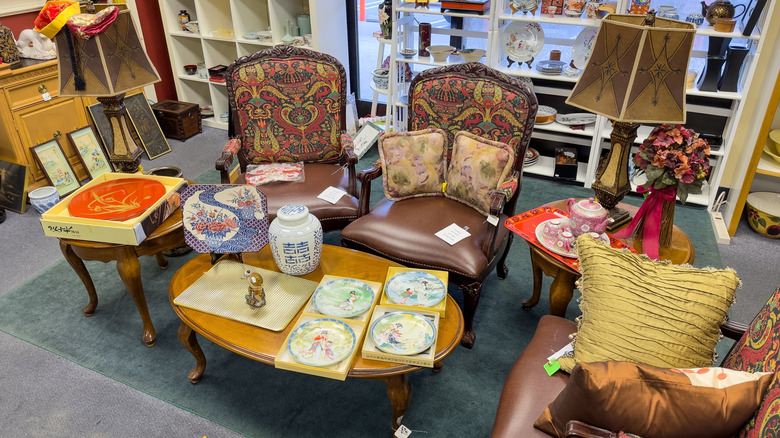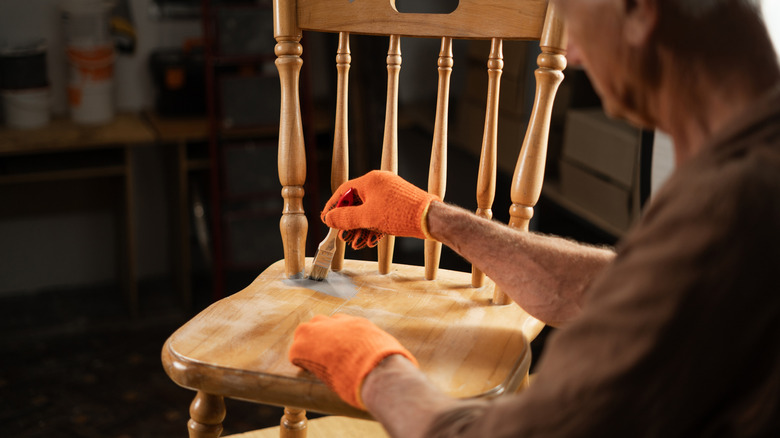The One Exception To Avoiding Upholstered Items At The Thrift
If you've spent any time combing through the aisles of your local thrift stores, you've probably heard the golden thrifting rule — stay away from any upholstered furniture when you're shopping the thrift. And there's plenty of good reasons for that trusted adage: Old couches and armchairs can be breeding grounds for dust mites, mystery stains, pet dander, and even hidden pests. Make no mistake, while thrifting itself can be a goldmine for decor lovers and vintage seekers, upholstery is usually placed among the riskiest of choices when considering what home items you should think twice before buying at a thrift store.
But there is an exception to that rule. That is, if you're planning to reupholster a piece of furniture yourself — and you know what you're looking for — there could be a potential furniture gem hidden beneath some otherwise suspect fabric. In fact, interior designers frequently say the key to this is spotting "good bones," like solid hardwood frames, clean joinery, and sturdy spring construction. When training your eye to spot high-quality furniture at thrift stores, remember that durable materials and craftsmanship often outlast aesthetics. This means that an eyesore on the outside could be structurally sound on the inside, and well worth the makeover. With a little vision and some elbow grease, you can turn a $20 thrift chair into a bespoke showpiece — a total bargain when new retail prices for similar furniture builds can reach into the hundreds.
How to know when thrift furniture is worth reupholstering
Indeed, even though upholstered furniture is almost always singled out as the main type of furniture you should avoid buying at the local thrift store, this is one big "but" that designers and design-minded thrifters swear by. Think of it as less like buying a finished product and more like sourcing raw materials for a project when looking for the "good bones" of a diamond-in-the-rough furniture find. Plus, when you completely reupholster a piece of furniture from the thrift, the risk of possible allergens or pests is reduced by a large margin. After all, when you're stripping the piece down to its core, the game completely changes.
What you want to look for are solid, hardwood frames — bonus points if they're doweled and glued, not stapled — along with tight joints and intact spring systems. Skip over anything with irredeemable furniture red flags like cracked legs, warped arms, or signs of water damage. Also, keep in mind that reupholstering isn't always a cheap or simple operation. Fabric, tools, labor, and time all add up. Still, if you've got a DIY streak and a piece with real potential, it could be a bargain transformation. In the end, thrift store upholstery is only off-limits unless you plan to give the piece of furniture new life yourself. For creatives or budget-savvy decorators, that's more than just a loophole, it's a shining thrifting opportunity.
Restoring furniture from the thrift the right way
If you've scored a thrifted piece with promise, your next move is crucial. How do you actually bring it back to life without wasting your time or money? For starters, be realistic about your skill level. Reupholstering isn't always beginner-friendly, especially for intricate shapes or tufted designs. But for simple chairs, ottomans, or even mid-century frames with straight lines, the process is more approachable than you might think. Tutorials and classes abound online, and there are plenty of smart tips from pros out there about upcycling and transforming furniture, which can make all the difference. However, you may want to think about outsourcing the labor if you're not comfortable doing the reupholstery yourself.
For the DIYers looking to dive in, make sure to fully strip the thrifted furniture's old fabric, check the padding, and disinfect every inch of the frame before starting. Replacing the inner foam is often worth the cost for comfort and hygiene. Then you're free to choose a fabric that matches your style and lifestyle – performance fabrics, for example, are great for families or pet owners. If your piece needs more TLC, you can learn how to bring your furniture back to life with solid strategies for refreshing wood accents, refinishing legs, or even adding new hardware. With the right prep and vision, what was once a passed-over item on a dusty thrift store floor could easily become a statement piece for your space.


